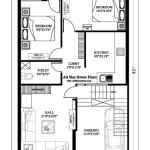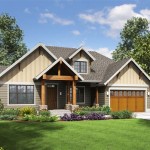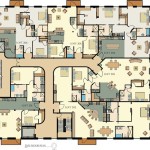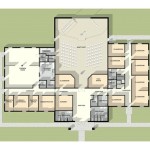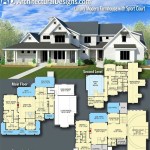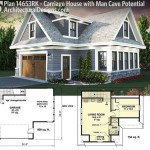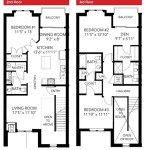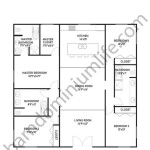Optimizing Space: Floor Plans for Small Houses
Designing a small house presents unique challenges and opportunities. Effective floor plans are essential for maximizing functionality, comfort, and aesthetic appeal within limited square footage. Careful consideration must be given to space utilization, layout efficiency, and the incorporation of strategic design elements. Successful small house design transcends mere downsizing; it demands a thoughtful approach to prioritize needs and create a living environment that feels spacious and inviting.
The initial stage of designing a small house involves a comprehensive assessment of individual needs and lifestyle. This includes determining the number of occupants, identifying essential activities, and establishing priorities regarding living, working, and storage space. Once these requirements are clearly defined, the floor plan can be tailored to optimize every square inch. A well-designed small house should not feel cramped or restrictive; rather, it should be a comfortable and functional living space that meets the specific needs of its inhabitants.
Several key strategies and considerations contribute to the success of floor plans for small houses. These encompass open-concept layouts, multi-functional spaces, vertical space utilization, strategic storage solutions, and the integration of natural light. By carefully implementing these elements, architects and designers can create small houses that are both practical and aesthetically pleasing.
Open-Concept Living: Fostering a Sense of Spaciousness
The open-concept layout is a cornerstone of small house design. By eliminating or minimizing walls between living areas, such as the living room, dining room, and kitchen, a sense of spaciousness and flow is achieved. This layout allows natural light to penetrate deeper into the house, further enhancing the feeling of openness. Visual barriers are reduced, creating a more cohesive and inviting environment.
While an open-concept layout offers several advantages, it is crucial to carefully consider the placement of furniture and appliances to define distinct zones within the shared space. Area rugs, strategically placed furniture groupings, and changes in flooring can help delineate different areas without the need for physical walls. Thoughtful consideration of traffic flow is also essential to ensure smooth movement throughout the space.
The kitchen, often a focal point in a home, requires careful planning in an open-concept layout. Countertops can serve as both food preparation areas and informal dining spaces, while islands provide additional workspace and storage. The selection of appliances should prioritize space-saving designs, such as integrated dishwashers and compact refrigerators. The overall design should seamlessly integrate the kitchen into the living space, creating a unified and harmonious environment.
Noise control can be a concern in open-concept living spaces. Incorporating sound-absorbing materials, such as upholstered furniture, area rugs, and acoustic panels, can help mitigate noise transmission and create a more comfortable living environment. The strategic placement of furniture and the use of soft materials can effectively dampen sound and reduce echoes.
Multi-Functional Spaces: Maximizing Versatility
In small house design, the concept of multi-functional spaces is paramount. Rooms should be designed to serve multiple purposes, adapting to different needs throughout the day. This approach maximizes the utilization of available space and reduces the need for dedicated rooms that may be infrequently used.
The living room, for example, can be designed to function as both a relaxation area and a guest bedroom. A sofa bed or a pull-out couch can provide comfortable sleeping arrangements for visitors, while the room can be easily transformed back into a living space during the day. Storage ottomans and coffee tables with built-in storage can further enhance the room's versatility.
Home offices are increasingly important, even in small houses. A dedicated workspace can be integrated into a living room or bedroom by utilizing a folding desk or a wall-mounted workstation. These solutions provide a functional workspace when needed and can be easily concealed when not in use. The integration of vertical storage, such as shelves or cabinets, can further optimize the workspace.
Dining areas can also be designed to serve multiple purposes. A dining table can double as a work surface or a hobby area. Folding chairs or stools can be stored away when not in use, freeing up valuable floor space. The use of a drop-leaf table can provide additional dining space when needed and can be reduced in size when not in use.
Vertical Space Utilization and Strategic Storage: Expanding Perception and Functionality
The utilization of vertical space is a critical aspect of small house design. By extending storage and design elements upwards, the perception of height and spaciousness is enhanced, and valuable floor space is preserved. This approach involves incorporating tall shelving units, wall-mounted cabinets, and lofted areas to maximize storage and create visual interest.
Tall shelving units can provide ample storage for books, decorative items, and other belongings. These units can be placed against walls or used as room dividers to create distinct zones within an open-concept layout. The use of adjustable shelves allows for customization and adaptation to changing storage needs. When selecting materials, consideration should be given to durability and aesthetic appeal to ensure that the shelving unit complements the overall design.
Wall-mounted cabinets are particularly useful in kitchens and bathrooms, where floor space is often limited. These cabinets provide storage without occupying valuable floor space, creating a cleaner and more streamlined appearance. The use of mirrored doors can further enhance the sense of spaciousness by reflecting light and creating the illusion of a larger room.
Lofted areas can be used to create additional living or storage space. A lofted bedroom or reading nook can provide a private retreat without requiring a significant increase in the overall footprint of the house. Lofted storage areas can be used to store seasonal items or infrequently used belongings. Careful consideration should be given to accessibility and safety when designing lofted areas, ensuring that they are easily accessible and meet all relevant building codes.
Strategic storage solutions are essential for maintaining a clutter-free and organized living environment in a small house. This includes incorporating built-in storage, utilizing hidden storage compartments, and maximizing the use of underutilized spaces. The goal is to create storage solutions that are both functional and aesthetically pleasing.
Built-in storage can be incorporated into walls, floors, and furniture. Built-in closets, drawers, and cabinets provide seamless storage that integrates seamlessly into the design of the house. Window seats with built-in storage compartments can provide comfortable seating while also offering hidden storage space. Built-in storage solutions can be customized to meet specific storage needs and can be designed to complement the overall aesthetic of the house.
Hidden storage compartments can be incorporated into furniture, such as coffee tables, ottomans, and benches. These compartments provide discreet storage for items that are frequently used but not always on display. Hidden storage can help maintain a clean and organized living environment by keeping clutter out of sight.
Underutilized spaces, such as under-stair areas and attic spaces, can be transformed into functional storage areas. Under-stair storage can be used to store shoes, coats, and other items. Attic spaces can be transformed into storage areas for seasonal items or infrequently used belongings. By maximizing the use of these underutilized spaces, valuable storage space can be created without increasing the overall footprint of the house.
In conclusion, floor plans for small houses require a focus on efficient space utilization. By implementing open-concept layouts, designing multi-functional spaces, and utilizing vertical space effectively, designers can create small houses that are both comfortable and functional. Strategic storage solutions and the integration of natural light further enhance the living experience in a small house, ensuring that every square inch is utilized to its full potential.

10 Small House Plans With Open Floor Blog Homeplans Com

Small House Design 2024001 Pinoy Eplans Floor Plans

27 Adorable Free Tiny House Floor Plans Small

27 Adorable Free Tiny House Floor Plans Craft Mart

These Small House Plans Pack A Lot Of Punch Houseplans Blog Com

10 Small House Plans With Open Floor Blog Homeplans Com

Plan 73931 Detached Guest House Or Tiny With Photos

540 Best Small House Plans Ideas

Small House Plans With S Houseplans Blog Com

Villoresi Small Luxury House Plan Courtyard

